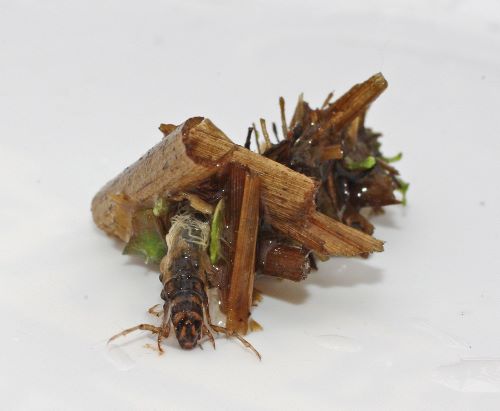
by Kate Redmond
Caddisfly revisited
Greetings, BugFans,
The BugLady is suffering from the February Doldrums in January – this is a massaged version of a BOTW that was originally posted in 2009, with some new words and new pictures.
“What’s in a name? A rose by any other name would smell as sweet.” What indeed? The BugLady will get back to that.
Caddisflies, in the Order Trichoptera (“hairy wings”), are famous for the cases built for protection by their soft-bodied larvae (the only natural “armor” they possess is located on their head, thorax and legs) and for the larvae’s ability to produce silk thread via a silk gland in their lower lip. They use silk to “glue” materials together to construct the case, to net some food, and to modify the case before they pupate.
Caddisfly larvae live in both running and still water; in fact, according to Elsie Klots in The New Fieldbook of Freshwater Life, they are one of four orders of insects that “have become almost wholly aquatic during their immature life.” The larvae of one European species live in wet moss, and the larvae of another, called the Land Caddisfly (Enoicyla pusilla), are terrestrial, but they still make cases out of materials they find in the leaf litter where they live. Female Land Caddisflies are wingless.
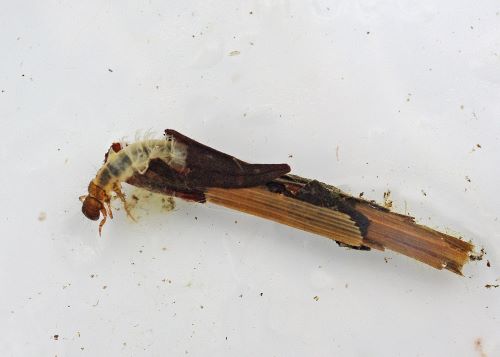
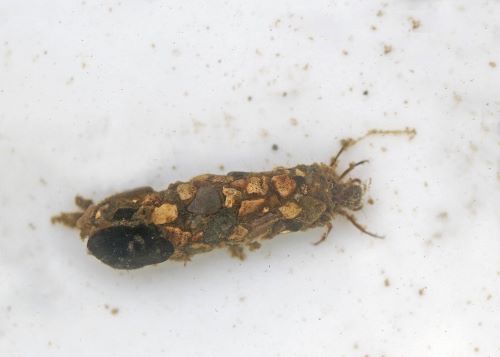
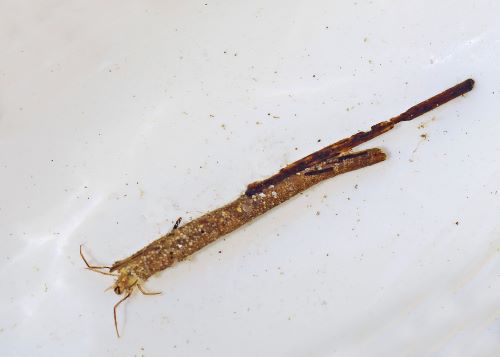
Many of the pond dwellers cut and assemble small bits of vegetation into portable homes. Some “homes” are thin tubes, some get glued together “the long way,” and some resemble Lincoln-log-like chimneys made of mini-twigs, sedges or cattails custom-trimmed by the larva. In streams or rivers, where staying in one place is a challenge, the larvae use heavier building materials like tiny pieces of gravel, or they spin a net that they glue onto a rock or into a crevice. Unlike turtles, whose shell and body are joined, caddisflies can leave their case of sticks or stones. Naked – deprived of their homes – they look like little wet caterpillars (to whom they are not-so-distantly related).
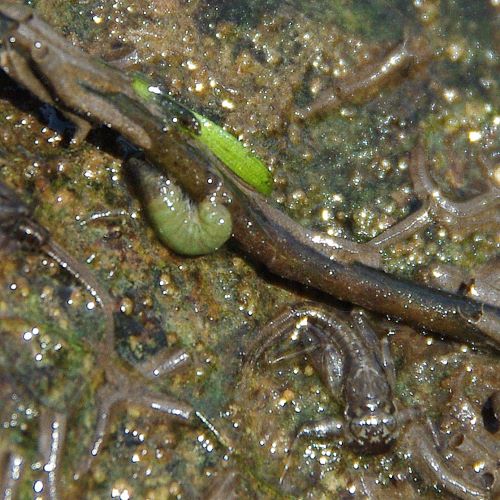
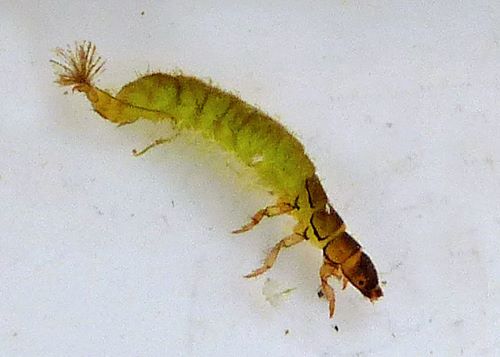
Cases are open at both ends, to facilitate oxygen circulation, and in very still water, the larvae must be more active in order to make up for the lack of a current. Caddisfly larvae are so specific about their choices of building materials that they can be classified down to family and sometimes genus, by the structure of their shelter.
The caddisflies, also called sedge-flies and rail-flies (and “fish food”), are a big order, with more than 15,000 species worldwide. North America boasts around 1,500 species of Tri-cops (as they are known familiarly), and not surprisingly for such a large group, their larvae indulge in a wide variety of feeding methods. There are predators and scavengers. There are “shredders” that perform the valuable service of turning big pieces of vegetation into little ones, thereby setting the table for even smaller organisms. Some net-spinners are “collectors” that let the current deliver their meals (bits of organic material) “carry-out” (some net-spinners can produce a sound by rubbing a front leg against the underside of their head). Finally, there are “scrapers,” grazing on algae and other tiny organic particles stuck to underwater surfaces. As adults, with mouthparts that are described as “sponge like,” they ingest only liquids, and many species don’t feed as adults.
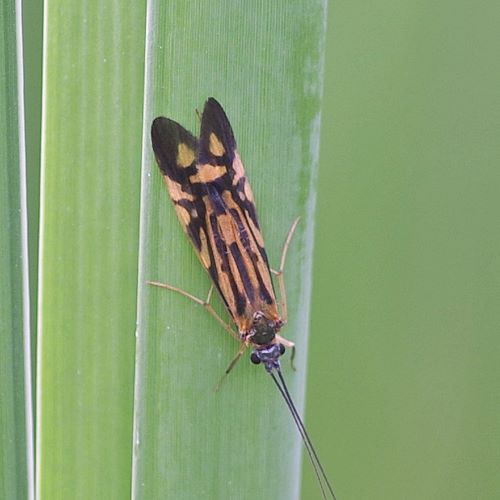
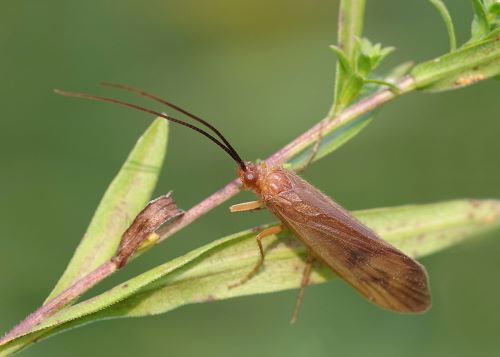
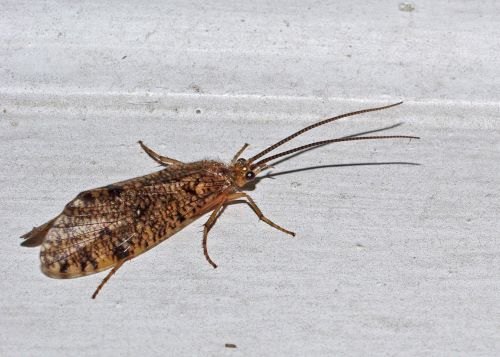
Adult caddisflies resemble slim, very long-antennaed moths; they tent their wings above their abdomens (making them look triangular from the rear), and their wings are covered with tiny hairs. Females of some species actually climb under water to lay their eggs, protected from getting soaked by a thin layer of air trapped in that dense covering of hairs. According to Eaton and Kaufman in the Field Guide to Insects of North America, fly-tiers (or tie-flyers) work hard to replicate caddisflies with their lures. Exceptionally sensitive to pollution, the presence of caddisflies signals good water quality. And, with a little luck, trout.
Once, when the BugLady gave a presentation about Pond Life to third graders, a child asked where the caddisfly got its name. The BugLady did not know, but she loves to research the etymology of entomology, so she promised to find out, and here is what she discovered. Back in the days of the first Queen Elizabeth (when Romeo and Juliet were obsessing about names) (and in the midst of the Little Ice Age – fascinating – look it up), itinerant peddlers roamed the world. Those who sold ribbons, threads and yarns were called “Cadice-men” after “cadaz/caddis/caddice” – words that had come to refer to worsted yarn. Cadice-men displayed their wares by attaching samples of threads and yarns to their coats. In his wonderful A Guide to Common Freshwater Invertebrates of North America, J. Reese Voshell, Jr. says that the larva’s ability to glue pieces of material together to make its case was reminiscent of how a Cadice-man covered his jacket with pieces of textile. Alternatively, it may refer to the fringe on the adults’ wings. Was the person who named caddisflies, like the BugLady, a bug-loving history-geek?
If you search online, you can find jewelry made out of caddisfly cases – entrepreneurs supply caddisfly larvae with a variety of bling, and the larvae incorporate it into their cases.
Kate Redmond, The BugLady
Bug of the Week archives:
http://uwm.edu/field-station/category/bug-of-the-week/
